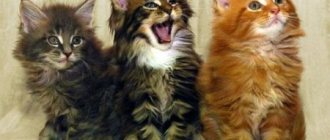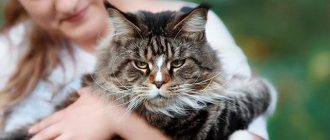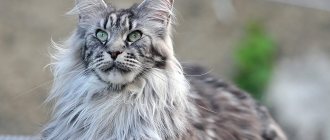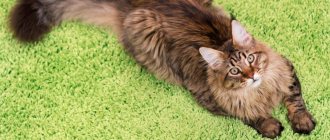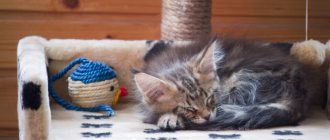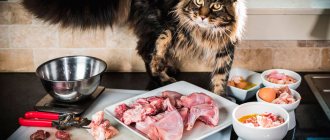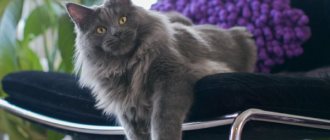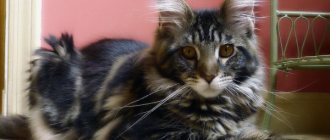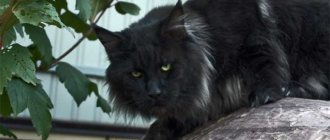Maine Coons are friendly, very beautiful domestic cats of American origin. This rather rare, but already popular breed surprises with its weight and size. Anyone who wants to become the owner of such a cat, encounters these animals at exhibitions or sees photos of a Maine Coon cat on Internet sites, is primarily interested in the question of what body weight this pet can achieve.
There are legends about giant cats whose weight exceeds 20 kg, but in reality there are no such representatives of this species. None of the exhibitions have ever registered a cat with such an indicator. The largest, most massive animals weigh up to 7 kg for cats and no more than 10 kg for cats.
Even neutered representatives of the breed who have excess fat deposits do not weigh more than 12 kg.
As a rule, cats are smaller than males, but some two-year-old females can be significantly larger than a one-year-old cat. Cats become larger after their first birth. And cats used for breeding can be very thin, since the mating process requires a lot of energy from the animal.
Neutered Maine Coons look the most standard for the breed, since their weight is not affected by hormonal fluctuations: they are always in an excellent mood and stand out with their magnificent coat. Castration also provides other benefits: it minimizes possible marks and unpleasant sprees. See also: when to castrate a Maine Coon.
The main condition for raising a castrate is strictly dosed feeding and physical activity to regulate the animal’s weight.
The apparent massiveness is achieved due to the fact that Maine Coons have a long, elongated body. The length of the cat’s body from the nose to the end of the heavily pubescent tail can be more than a meter: the current record is 1 m 23 cm.
In addition, they have very solid muscles, strong paws, a large head set on a massive neck, and a voluminous collar on the shoulders. Therefore, a cat weighing 9 kg sometimes gives the impression of a very large animal weighing 15 kg or more.
But even a well-fed cat that has lost kilos will weigh less than an overfed one, but will not be inferior in size. The geographical location of the cat's raising, the characteristics of its maintenance and its growth do not in any way affect the standards of the animal's breed.
Maine Coon sizes: weight and height by month
Future owners and just people who have seen a Maine Coon for the first time are interested in what height and weight this cat reaches.
The elongated body, large head, paws and tail, developed muscles and long hair give the impression that this is a very massive animal. There are stories that say Maine coon cats gain up to 15-20 kg. And many owners try to fatten their pet to such parameters. You should approach this with caution. It is useful to know what sizes are normal for Maine Coons, so as not to harm your pet.
Deviations from the norm
Insufficient weight gain and decreased body weight are allowed only during the initial stage of growth, during the first week of life. At the neonatal stage, weight gain and height depend on the characteristics of labor.
This is interesting! In the first four days, even minor weight loss is allowed, which is steadily restored in the coming days.
If an animal whose age is more than a couple of months loses weight, then it is necessary:
- introduce more high-calorie foods into the diet;
- make a competent change in diet;
- supplement the diet with a vitamin-mineral complex;
- use dietary supplements in feeding that stimulate the appetite, as well as quickly normalize the functioning of the stomach and intestinal tract.
It should be noted that at three to four weeks the kitten’s body weight may gradually decrease, which is explained by the transition of the pet from mother’s milk to solid food. And starting from seven weeks, the animal’s weight gains again.
Important! Solid, complete diets with beneficial microelements, vitamins and minerals promote weight gain.
The owner of a Maine Coon should be wary not only of the pet’s underweight, but also of the pet’s excessive body weight . If necessary, you should consult with veterinary specialists who can correctly determine the cause of deviations from the normal weight and height of the Maine raccoon cat.
How much do Maine Coons weigh: table
Unlike other breeds, Maine cat kittens are born large. The average weight of a newborn Maine Coon is 130-145 g. But it can be 100 or 200 - it depends on the number of cubs in the litter. Usually 4-6 kittens are born, rarely 1-2 or 7. So, for example, if there are 7 kittens in the litter, then the average weight of each baby is 115 g, if 4 - 125 g.
This is still more than the indicators of other breeds:
- Norwegian forest – 110 and maximum 150 gr.
- Persians – 60-120 gr.
- Siamese – 60-130 gr.
- British - 100, maximum 140 g.
The little Maine Coon kitten is growing quickly. In the first week he doubles his weight. If development proceeds correctly, then the daily normal increase in body weight is 10%.
By 10 days of age the weight increases by 2.5-3 times, by 1 month by 5-6 times, by 2 months by 8-10 times.
At 1 month the weight of a Maine Coon is 0.5-0.8 kg. At about 3-5 weeks, kittens begin to be fed. During the transition period, the pet may not gain weight.
After a complete transition to food, the kitten begins to gain weight again. At the age of 2 months, weighing shows 0.8-1.5 kg.
When a Maine Coon is weaned from its mother, it weighs 1.5-2 kg, while an ordinary cat at this age weighs 0.5-0.6 kg.
The Maine Coon weight table provides information on the development of kittens from birth to 2 months:
| Age (by week) | Girls (in gr.) | Boys (in gr.) |
| At birth | 115-145 | 118-145, less often up to 170 |
| 1 | 240-260 | 230-280 |
| 2 | 340-400 | 350-410 |
| 4 | 560-740 | 620-820 |
| 6-8 | 1150-1400 | 1200-1400 |
The dimensions of newborn females and males do not differ. Sex differences begin to appear at approximately 3 months of age. During this period, girls and boys differ markedly in size.
Maine Coon weight by month: table (category “Kittens”):
| Age (by month) | Cats | Cats | ||
| Minimum (in kg) | Maximum (in kg) | Minimum (in kg) | Maximum (in kg) | |
| 3 | 1,65 | 2,9 | 1,9 | 3,2 |
| 4 | 2,55 | 3,35 | 2,7 | 3,9-4 |
| 5 | 3 | 3,8 | 3,5 | 4,8 |
The Maine Coon's size increases most actively during the period of 4-6 months. At this stage, animals have increased energy metabolism, which owners must take into account when organizing nutrition.
At 4 months, Maines weigh the same as regular adult cats, and at the same time they look like kittens.
Maine Coon kitten weight by month (Junior category):
| Age (in months) | Females | Males | ||
| Minimum (in kg) | Maximum (in kg) | Minimum (in kg) | Maximum (in kg) | |
| 6 | 3,3 | 4,7 | 3,7 | 5,1 |
| 7 | 3,3 | 4,7 | 4,2 | 6,5 |
| 8 | 3,7 | 5,2 | 4,6 | 6,7 |
| 9 | 4,1 | 5,5 | 5 | 7,62 |
After 10 months, representatives of the breed are considered adults. At 1 year old, the female weighs 4.5-6.8 kg. And the weight of an adult male Maine Coon reaches 5.7-9 kg.
Birth weight
Maine Coons are the largest domestic cats in the world.
Their kittens at the time of birth weigh on average about 115-120 g. Girls are born smaller - 85-145 g, boys - 100-170 g.
Maine Coons are the largest domestic cats in the world
It has been observed that large newborn Maine Coons grow faster than their smaller counterparts.
How old do Maine Coons grow?
After the Maine Coon turns one year old, weight gain gradually slows down. However, the muscles and bones are not completely formed by the first mating in males or the birth of females, as happens in other breeds. Weight gain in the breed continues up to 3 and even 4 years, especially in males. In American-type coons, maturation is even later - up to 5 years.
If a cat is untied at one year old, then he still remains a kitten by Maine Coon standards. At the same time, many owners have a concern: if they untie their pet early (before 2 years), it will stop growing. Veterinarians and breeders consider this judgment to be incorrect.
From 8 months to 1.5 years is considered the optimal age for untying a male.
If the first mating occurs after 2 years, then there are many cases of failure due to the cat’s lack of experience.
By the age of 3, animals mature and reach their maximum size. So cats gain 4.5-6 kg in weight. In some (rare) cases – up to 8 kg. Male - 7-9 kg. A castrated cat can gain up to 10 kg.
Higher figures and stories on the Internet about Maine cats whose weight is 15 and even 20 kg are nothing more than fiction. No cats weighing more than 10 kg were registered at any exhibition, even in the “neutered” category.
The result was:
- Males and cats over 10 kg are included in the category of those who do not give birth.
- Animals over 9 kg show signs of obesity.
- After 3 years of age, every second cat gains 8 kg.
- The average Maine Coon weighs 7.4 kg.
Factors influencing development
The development of cats is influenced by the following internal and external factors:
- Floor. The male develops faster, grows larger and 2-3 kg heavier. Already at 3 months, boys are much heavier than girls.
- Mother's sizes. The larger the female, the faster the kittens grow in size.
- Genetic factors. Breeders note that kittens from the same litter develop at different rates. However, if you want to know how big your pet will grow, you need to look at the parents, or better yet, at the grandparents, if possible.
- Stress. The development of a kitten, especially when it has just arrived in the house, is affected by the stress of moving, a new environment, and a different diet. During this time, your pet may lose weight.
- Balanced kicking. Feeding a pregnant cat and her babies is also important.
- Conditions for physical exercise. Maine cats need exercise to develop and grow.
- Presence of diseases. Diseases suffered during a period of active growth, taking medications, especially antibiotics and hormones - all this can slow down development. For these reasons, there are cases when the size of an adult Maine Coon differs little from that of an ordinary cat.
Linear growth rates
Mostly cat lovers are interested in information about the fatness of Maine cats. Therefore, participants began to be weighed at exhibitions.
However, the data on how long Maine Coons are is no less interesting; it’s not for nothing that they occupy first place in the ranking of the largest domestic cats. Moreover, in many photos, owners try to demonstrate the size of the pet, taking pictures when it is stretched out in length.
The average height and length are as follows (in cm):
- The body is rectangular, elongated. Body length – 95 +/- 5
- The tail is long and very fluffy. Length – 35 +/-2
- Height at withers – 32.5. There is information about a height of 40 centimeters.
- Waist and chest girth – 32.
It also takes a Maine Coon 3-4 years to reach its full length. The largest representative of the breed listed in the Guinness Book is the cat Stewie. The length of his body from the tip of his tail to his nose was 123.2 cm.
What to feed a Maine Coon: kitten, adult cat
Is it possible to cut a Maine Coon's hair?
How to name a Maine Coon: nicknames for cats and cats
How to distinguish a Maine Coon from an ordinary cat: 5 signs of thoroughbred
Maine Coon Polydact: a little larger than usual
Sterilization and castration of Maine Coons: features
Source
CFA
According to the general description, Maine Coons are strong cats with great endurance and are adapted to life in difficult climatic conditions. These are well-balanced and harmoniously built animals, without signs of excess. The main feature of the breed is its smooth and shiny coat. When assessing a particular specimen, type, not size, is of paramount importance.
Description of the standard:
- Head. It has medium length and width, a square-shaped muzzle. A wider head does not cause fines or disqualification of the animal, if we are talking about stud cats.
- Ears. Large, with pointed tips and tassels on them. Set wide and high, the distance between them approximately coincides with the width of the ear at the base.
- Eyes. Large, slightly convex, set wide and slightly oblique. They can be green, gold, golden-green or copper. Blue eyes are allowed only in representatives of the breed with a white coat or bicolors.
- Body. Medium or large, rectangular, well-developed muscles. The neck is of medium length, the chest is wide.
- Limbs. Strong, medium length, proportional to the body. The pads are round and there are tufts of fur between the toes. The front paws have 5 toes, the hind paws have 4.
- Tail. Long, tapering towards the end, covered with long hair.
- Coat. Fluffy, long, silky. Shorter on the shoulders than on the belly and hind legs.
- Coat color. White, black, blue, red, cream colors, various variations of tabby and tipping colors are allowed.
Reasons for disqualification:
- Light frame.
- Wedge-shaped or narrow muzzle.
- Malocclusion.
- Strabismus.
- Noticeable use of cats of other bloods when breeding an animal.
Chocolate, lilac, cinnamon or Siamese coats are not acceptable.
Adult size standards
The Maine Coon is the largest breed of domestic cat. Males, both at birth and as adults, are significantly larger than females. The average weight of an adult cat is 8-14 kg. The body weight of a cat ranges from 5 to 7 kg. Spayed and sterilized pets gain weight much better, and their weight is about 3-4 kg more. Newborn kittens weigh 100-150 g. This is 1.5 times more than the weight of outbred babies.
The body size is also impressive. The body length of an adult cat reaches 120 cm. The average tail size is 50-55 cm. The height at the withers ranges from 24 to 44 cm. Some individuals have larger body parameters.
Trying to raise a huge Maine Coon, many owners try to feed their pet high-calorie “human” food (sweets, fast food, fatty fried meat). You can't do this. The pet will become obese, which negatively affects the health of large breed cats.
Breed Features
Recently, scientists are increasingly inclined to believe that the homeland of Maine Coons is the territory of Maine, in the northeastern United States.
The natural conditions in this region are quite harsh. The climate is cold, strong winds, and a lot of snow falls in winter. As a result of natural selection over a long period of time, this variety was formed.
The description of the breed includes the following main points.
- Large sizes - length on average about one meter.
- Impressive weight - from 6 to 12 kg.
- A strong and graceful body of an oblong shape, with strong muscles.
- Large head, heavy shoulders and neck.
- Powerful paws with fur between the toes.
- The most varied colors , including two- and three-colored individuals.
- Very thick and long fur that is not afraid of moisture and almost does not get wet from snow.
- Luxurious fluffy tail , more than thirty centimeters long.
- Tassels on the ears, just like a lynx . The ears themselves are also pubescent and covered with thick hair, which serves as additional protection from frost.
- The sounds made by animals - something between a rumbling and purring - are characteristic only of this breed.
To what age do they grow?
Often, beginning Maine Coon breeders sound the alarm when, after 2-3 years, they discover that the pet is significantly less than the parameters of an adult. The owner often associates such a lag with the presence of hidden diseases or with the cat not being purebred. However, such fears are premature.
The development of a Maine Coon cat can only be fully assessed by the age of 4-5 years. It is at this age that representatives of this breed completely stop growing. While an ordinary cat reaches adult body parameters by the age of 1 year.
Despite the fact that representatives of the Maine Coon breed grow up to 4-5 years, they reach sexual maturity much earlier - by 1-2 years. Often after the first mating, pets make a significant leap in growth.
Record holders
According to the Guinness Book of Records, the longest cat is the Maine Coon Stewie, whose full name is Stuart Gilligan. Its length was 123 cm. The record was set in the USA on August 28, 2010. Stewie died in 2013. The current record holder for length is another Maine Coon cat named Ludo, whose length is 118.33 cm.
What does the development of the Maine Coon depend on?
Despite the presence of average norms of body parameters for representatives of the Maine Coon breed by month, the pet’s height and weight are individual parameters. These values largely depend on several factors:
- Sexual dimorphism. Male kittens grow much faster than their sisters. Accordingly, the size of adult males is also much larger.
- Heredity. If a mother cat and a father cat are small in body size, then their offspring are unlikely to grow larger. And on the contrary, strong, stocky parents give birth to large kittens, whose height in adulthood reaches 120 cm or more. The purebred nature of the kitten also matters; mestizos are often sold under the guise of Maine Coons. Such babies will reach sizes that are significantly behind the established norms.
- The condition of the baby at birth. Often in one litter there are both large kittens weighing 130-150 g and weakened newborns. The weight of the latter can be only 80-90 g. Subsequently, the growth rate of “weakened” kittens noticeably lags behind the norm.
- Conditions for keeping the female while bearing and feeding babies. In the womb, as well as during breastfeeding, the health of kittens depends entirely on the well-being of the mother. If the cat gets enough rest, eats well, and is protected from stressful situations, then newborns will grow quickly and gain weight.
- Psychological state of the pet. Maine Coons are affectionate, sociable animals that constantly need human company. If a kitten grows up from an early age in a family where there is quarreling or tense relationships, then its growth rate is noticeably reduced. Loving, caring owners, on the contrary, grow large pets.
- Presence of diseases. A sick animal spends a lot of energy fighting the disease. Therefore, growth slows down significantly. Maine Coon breeders need to take their kittens to the veterinarian from a very early age.
- Nutrition. In order for the Maine Coon to grow healthy and big, it is recommended to feed it with specialized premium or super-premium food. You can also give your pet natural food. The Maine Coon's diet should include lean meat, sea fish, dairy products, fruits and vegetables, and cereals.
Kittens from small litters usually grow larger and tougher. While the babies of “large families” cats are characterized by small parameters and often poor health.
The development of Maine Coons is also influenced by the conditions of detention. Cats that live in apartment conditions grow slower and get sick more often. Pets that spend a lot of time outdoors, on the contrary, are distinguished by good health and active development rates.
What affects the size of a cat?
In addition to gender, the weight and height of a maecoon depend on genetic factors, particularly the size of the mother. It is also important how well the cat ate during pregnancy. Illnesses and stress of a pregnant female also negatively affect the health and, accordingly, the size of the kittens. This dependence continues during lactation.
Medications taken either by the pregnant cat or by the babies themselves can change the rate at which a Maine Coon gains weight, up or down. The size of Maine Coon kittens is also affected by the size of the litter. If there is only one Maine Coon kitten, it can weigh up to 140 g; for two, the normal value decreases to 130–135 g.
If there are five babies in the litter, the normal weight for each will be 118–125 g. For the normal development of a Maine Coon kitten, good sanitary conditions and the absence of stress, such as sudden changes in temperature, drafts, intrusive attention from other pets or children, loud noise or music, etc. Strong excitement at this age changes the hormonal background of the kitten, which negatively affects the rate of its development.
Since Maine Coons grow very quickly, the owner must provide them with proper nutrition - without overfeeding, but also not forgetting to gradually increase portions.
It is important to introduce new foods into the diet in a timely manner. This pet can be fed with both natural and dry food. The transition from one type of power supply to another should be smooth.
Similar article: Description of the breed and features of keeping a Maine Coon cat
Why is the Maine Coon not growing or gaining weight?
Sometimes Maine Coon cats not only gain weight poorly, but also lose weight. Such problems usually arise due to the following reasons:
- There is a lot of competition among newborn kittens. If there are many babies in the litter, not everyone may get enough milk. In such a situation, the breeder must help the lagging kittens get adequate nutrition.
- Health problems. Not all diseases have clearly defined symptoms. Some illnesses occur in a latent form. Therefore, the pet needs to be examined periodically. Recent or current illnesses lead to stunted growth and development.
- Lack of timely vaccination. The first vaccination for a Maine Coon kitten is given at 2.5 months. Next, the vaccination schedule is agreed upon with the veterinarian.
- Poor nutrition. Often, owners of domestic cats try to fatten them with their favorite delicacies. However, human food is strictly contraindicated for Maine Coons. For full growth and development, it is necessary to provide the cat with a balanced diet with a predominance of protein foods.
- Presence of fleas or helminths. Parasites take away a significant amount of strength and energy from the animal.
What to do if the kitten is not gaining weight?
If the kitten begins to noticeably lag behind its brothers and sisters in size and stops gaining weight, then it should be monitored.
The reasons for the lag may be the following:
- disease;
- stress, especially when changing the usual environment, which soon passes;
- The baby can be eaten by larger kittens.
Be sure to read:
Polydactyly (hyperdactyly) in cats: polydactyly, broad feet, many fingers, what kind of deviation?
If the cub is not gaining weight, but looks quite healthy and cheerful, then it may be necessary to change its diet to something more nutritious.
The biggest Maine Coons
Some Maine Coons are significantly outside the norm for weight and height. Some huge representatives of this breed deserve special attention:
- A cat named Stewie from the USA was included in the Book of Records at the age of 5 years. The length of his body (without tail) was 123 cm. Despite his impressive size, Stewie's life expectancy was relatively short. The cat died at the age of 8 from cancer.
- The owner of the cat Rupert from Australia loved to post photos with her pet on social networks. Amazed Internet users were amazed by its parameters. At 3 years old, his weight was about 10 kg. Thanks to her furry friend, the woman's number of subscribers has increased dramatically.
- Another Australian record-breaking cat is the Maine Coon Omar. The length of its body, excluding the tail, is 120 cm, and its weight is 15 kg.
- The Italian cat Barivel grew to 120 cm at the age of 3 years. At the same time, he is quite sedentary and loves to sleep. And he is taken for a walk in a baby stroller. The cat's owners admitted that in addition to the right food for the Maine Coon, they periodically pamper him with cookies and ice cream.
- Maine Coon Garfield is the leader among Russian record holders. He lives with his owners in Moscow. Its weight is 13 kg, body length is 117 cm.
There is no universal formula for raising huge Maine Coons. The development of an animal depends on a complex of many factors, among which heredity plays a leading role. But owners of representatives of this breed should not despair. Regardless of body parameters, the Maine Coon will give its owner love and devotion. Which is much more important than body size.
The weight and size of Maine Coons by month is an important indicator that can tell you about the health of your pet. Therefore, it is so important for novice breeders to know the body parameters of cats of this breed. Deviations from the norm identified in time will help raise not only a large, but also a healthy cat.
Source
Feeding
The key to a pet’s well-being is proper nutrition. Here Maine Coons are also not picky, as they can eat both natural products and industrial food.
Natural nutrition
Natural feeding should not be understood as food from the table. This is a specific set of products in their pure form:
- meat (chicken, turkey, beef). Before serving, it is advisable to boil or pre-freeze;
- vegetables (zucchini, broccoli, carrots) - need to be chopped and served along with meat;
- sea fish – boiled;
- boiled egg yolks;
- cereals;
- low-fat dairy products.
Change the water to fresh water 1-2 times a day.
Feeding with industrial feed
Food is selected taking into account the weight and age parameters of the pet. Cats willingly consume extra-premium food, and for good reason, because they contain 50 percent meat.

